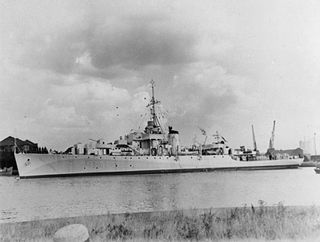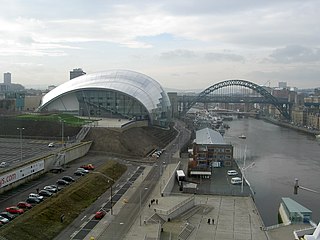HMS Ocean was a 98-gun second-rate ship of the line of the Royal Navy, launched from Woolwich Dockyard on 24 October 1805. She was the only ship built to her draught, and designed by Sir John Henslow.
Five ships and a shore establishment of the Royal Navy have been named HMS Mersey after the River Mersey:
Nine ships of the Royal Navy have been named HMS Severn after the River Severn:

The River-class destroyer was a class of torpedo boat destroyer built for the Royal Navy at the turn of the 20th century, and which saw extensive service in World War I. The class introduced new features to destroyer design, placing a greater emphasis on seakeeping and endurance and less on a high maximum speed in good weather. All the ships were named after British and Irish rivers, and as such were the first Royal Navy destroyer class to be named systematically.

UBS Mayu was the first flagship of the Burmese Navy. She was commissioned on 25 May 1947 and saw 32 years of active service during which she participated in many counter-insurgency campaigns, safeguarding Myanmar's territorial waters, and also served as training ship for the officers and ratings of Myanmar (Burma) Navy. The ship had been built as River-class frigate HMS Fal for the Royal Navy during World War II and was transferred to the Burmese government in 1947 on loan, and permanently in 1948. She was decommissioned in 1979 and was converted to a museum ship.

HMS Doon was a Hawthorn Leslie type River-class destroyer ordered by the Royal Navy under the 1903 – 1904 Naval Estimates. Named after the River Doon in western Scotland, she was the first ship to carry this name in the Royal Navy.

HMS Calliope is a training centre and 'stone frigate' of the Royal Naval Reserve, located in Gateshead, Tyne and Wear.

The Colony-class frigates were a series of 21 frigates constructed in the United States by Walsh-Kaiser of Providence, Rhode Island for transfer under Lend-Lease to the Royal Navy in 1944. They were given the names of relatively minor colonies as names of large colonies had been used for the Crown Colony-class cruisers.
HMS Colne was a Thornycroft type River-class destroyer ordered by the Royal Navy under the 1903–1904 Naval Estimates. Named after the River Colne in eastern England, north east of London, she was the first ship to carry this name in the Royal Navy.
HMS Blackwater was a Laird-type River-class destroyer ordered by the Royal Navy under the 1902–1903 Naval Estimates. Named after the River Blackwater in southern England near London she was the first ship to carry this name in the Royal Navy.
HMS Itchen was a Laird-type River-class destroyer ordered by the Royal Navy under the 1901–1902 Naval Estimates. Named after the River Itchen in southern England near Southampton, she was the first ship to carry this name in the Royal Navy.
HMS Moy was a Laird Type River-class destroyer of the Royal Navy. Named after the River Moy in Ireland, she was the first ship to carry this name in the Royal Navy.
HMS Nith was a White Type River Class Destroyer ordered by the Royal Navy under the 1903–1904 Naval Estimates. Named after the River Nith in southern Scotland, on the West Coast, she was the first ship to carry this name in the Royal Navy.

HMS Usk was a Yarrow type River Class destroyer ordered by the Royal Navy under the 1901 – 1902 Naval Estimates. Named after the River Usk in Wales flowing through Newport, she was the first ship to carry this name in the Royal Navy.
HMS Wear was a Palmer Type River Class Destroyer ordered by the Royal Navy under the 1903 – 1904 Naval Estimates. Named after the River Wear a river flowing through Sunderland on the East Coast of England, she was the first ship to carry this name in the Royal Navy.
HMS Jed was a Thornycroft type River-class destroyer ordered by the Royal Navy under the 1903 – 1904 Naval Estimates. Named after the River Jed in southern Scotland, she was the second ship to carry this name since it was introduced in 1814 for a 26-gun sixth rate ship sold in 1833.








